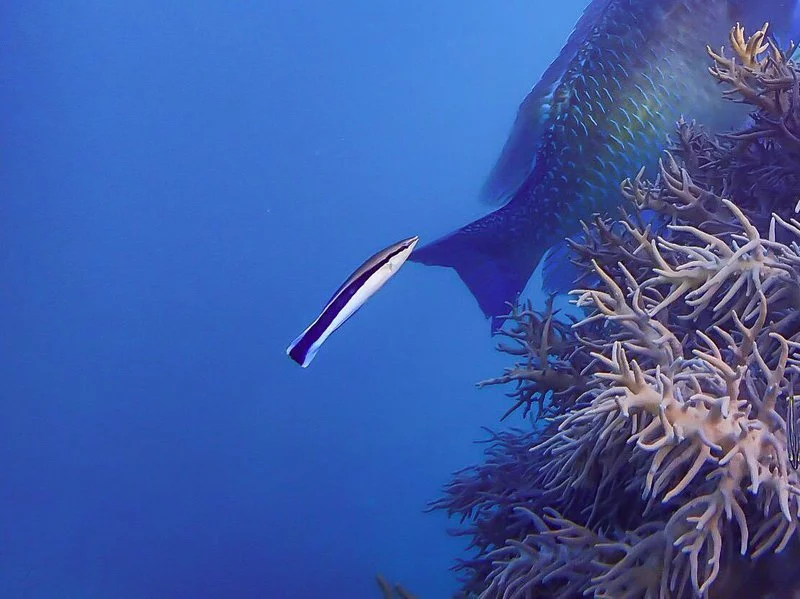The blue streak cleaner wrasse or cleaner wrasse Is a very common fish here in the Whitsundays
and along the great barrier reef. They have some cool quirks that make them very special and
vital to the ocean and all the animals that live in it.
The reason why these fish are so important and interesting is because of the role they play in
the ecosystem. They aren’t called cleaner wrasse by accident. These fish can play the role of the
ocean dentist. Cleaner wrasse set up cleaning stations for the reef’s residents, they will
display their beautiful colours by doing a little dance to let everyone know they are open for
business. Animals will remain very calm and stay as still as possible when they are around the
cleaner wrasse allowing the little fish to swim inside their mouths and around their gills
nipping off small parasites, dead skin or slime. They can also remove dead scales from fish which
promotes mucus growth and helps the fish fight off infection and boosts its immune system.
Cleaner Wrasse will set up permanent cleaning stations for sharks, turtles and even manta rays.
The cleaning stations that these fish set up are a neutral zone, the cleaner wrasse are never
attacked or prayed on, not even by the sharks. They have what we call a symbiotic relationship.
This means they benefit off each other. The cleaner wrasse gets a nice meal and its customer gets
those pesky hard to get parasites removed and a nice teeth clean. If a cleaner wrasse does happen
to get harmed or eaten, they will go on a strike and not clean anyone’s teeth until they have
been forgiven, this can take weeks. Cleaner wrasse are not very forgiving animals.
There have been reports of divers dropping their tanks and regulators near cleaner wrasse and
they have swum inside the diver’s mouth and given them a clean.
There are few fish that the cleaner wrasse doesn’t like, one of them being the box fish. Because of their thin skin the cleaner wrasse and potentially harm the box fish if they try to clean their scales. Puffer fish are easily stressed and will puff up to twice their size, the cleaner wrasse can scare them causing this to happen. Frog fish, lizard fish and scorpion fish have been known to eat the cleaner wrasse.
The cleaner wrasse is very easy to identify on the reef. They have a black stripe down the centre of its body and tend to be light iridescent blue on either side and a white belly. Typically, a long thin body, a pointy white nose and a wide flat tale. These beautifully coloured fish aren’t very big, they only grow to be about 5.5 inches or about 14 centimetres at maximum. There are a few different species throughout the world with slight colour variations but mostly quite similar.
The cleaner wrasse are found in the Indian ocean, from the east coast of Africa all the way to Polynesia. In depths ranging from one to thirty metres. These fish are commonly found in pairs and sometimes large groups but more commonly pairs scattered across coral reefs looking for their next meal. If there are no clients around, they will feed on seaweed, because they are such a small slender fish, they can’t store much food, so they do need to eat every twenty-four hours.
Trying to tell the difference between male and females can be almost impossible, although the males can be slightly bigger, they are identical in colour. In a group of cleaner wrasses there is always one dominant male. If there is an absence of a male a female will change sex and become the dominant male, but this will usually happen before the female turns three years of age.
We see these fish regularly in the Whitsundays aboard Wings Sailing Charters Whitsundays in many of our beautiful snorkel spots. Seeing these cleaner wrasse dance around and doing their bit for the ocean is a special moment when searching the coral gardens for special memories.

